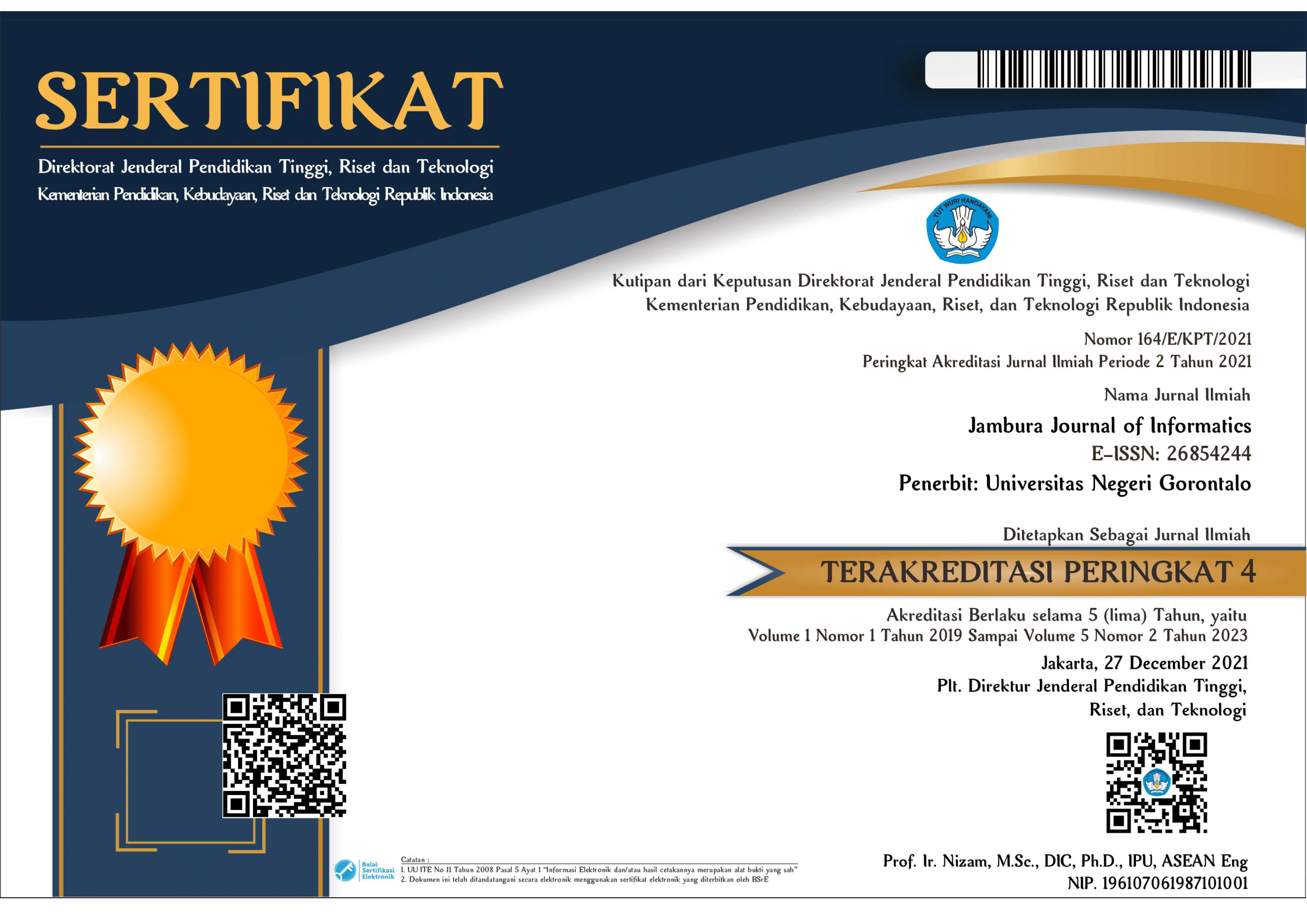Evaluasi Sistem Informasi Kemahasiswaan Terpadu Menggunakan Model HOT-Fit
Abstract
Sistem Informasi Kemahasiswaan Terpadu (SIMANTAP) is an online-based information system for student services within the Universitas Negeri Gorontalo. This application system can be accessed on the https://simantap.ung.ac.id page. The main problem faced in its application is the service process of issuing a Surat Keterangan Pendamping Ijazah (SKPI)/(Diploma Supplement), which is long enough for graduates to wait several months to receive SKPI documents. The purpose of this study was to evaluate the factors that affect SIMANTAP services, namely human, technological, and organizational factors, using the HOT-Fit model. This study uses a descriptive quantitative approach, and the data analysis technique is SEM-PLS using SmartPLS 3.0. The results of this study show that: (1) the successful implementation of the SIMANTAP application system in UNG is at the level of 77.7% and is included in the strong or successful category; (2) evaluation of the factors that affect the successful implementation of SIMANTAP in UNG are as follows: system quality and information quality have an influence on system use, service quality, and system use influence user satisfaction, the organizational environment has an influence on organizational structure, and organizational structure and organizational environment influence SIMANTAP's net benefit.
Sistem Informasi Kemahasiswaan Terpadu (SIMANTAP) merupakan sebuah sistem informasi berbasis online untuk layanan kemahasiswaan di lingkungan Universitas Negeri Gorontalo. Sistem aplikasi ini dapat diakses melalui laman https://simantap.ung.ac.id. Pada penerapannya, permasalahan utama yang dihadapi, yaitu lamanya proses penerbitan Surat Keterangan Pendamping Ijazah (SKPI) sehingga para wisudawan masih harus menunggu beberapa bulan untuk dapat menerima dokumen SKPI. Tujuan penelitian adalah untuk mengevaluasi faktor–faktor yang mempengaruhi layanan SIMANTAP dengan menggunakan model HOT-Fit. Penelitian ini menggunakan pendekatan kuantitatif deskriptif dan teknik analisis data adalah SEM-PLS dengan menggunakan aplikasi SmartPLS 3.0. Hasil penelitian ini menunjukkan bahwa: (1) keberhasilan penerapan sistem aplikasi SIMANTAP di UNG berada pada level 77.7% dan termasuk dalam kategori kuat atau berhasil; (2) evaluasi terhadap faktor-faktor yang mempengaruhi keberhasilan penerapan SIMANTAP di UNG adalah: kualitas sistem dan kualitas informasi memiliki pengaruh terhadap penggunaan sistem, kualitas layanan dan penggunaan sistem memiliki pengaruh terhadap kepuasan pengguna, lingkungan organisasi memiliki pengaruh terhadap struktur organisasi, dan struktur organisasi dan lingkungan organisasi memiliki pengaruh terhadap manfaat (net benefit) SIMANTAP.
Keywords
Full Text:
PDF (Bahasa Indonesia)References
Akbar, R., & Mukhtar, M. (2019). Evaluasi e-tracer study menggunakan HOT (Human- Organization-Technology) Fit model. Jurnal JTIK (Jurnal Teknologi Informasi Dan Komunikasi), 3(2), 46.
Amilin. (2016). Dampak penerapan good university governance terhadap kinerja manajerial melalui implementasi anggaran berbasis partisipatif. Jurnal Akuntansi, XX (03), 330-344.
Arikunto, S. (2010). Prosedur penelitian suatu pendekatan praktis. Jakarta: Rineka Cipta.
Chin, W. W. (1998). The partial least squares approach to structural equation modeling. Modern Methods for Business Research. 295, 336.
Cono, V. A., Surawan, R. I., & Katili, M. R. (2019). Evaluasi dan penilaian tata kelola teknologi informasi di Universitas Negeri Gorontalo. Jambura Journal of Informatics, 1(1), 37-46.
Ghozali, L. (2015). Partial least squares Konsep, teknik dan aplikasi menggunakan program SmartPLS 3.0 untuk penelitian empiris. Semarang: Universitas Diponegoro.
Henard, F., Mitterle, Alexander. (2010). Governance and quality guidelines in higher education. OECD.
Ibrahim, S. S., Mobulango, I., Yazni, Y., & Katili, M. R. (2021). Pengukuran kesiapan penerapan knowledge management di institusi pendidikan tinggi. Jambura Journal of Informatics, 3(2), 87-96.
Jogiyanto, H. M. (2011). Konsep dan aplikasi structural equattion modelling berbasis varian dalam penelitian bisnis. Yogyakarta: UPP STIM YKPN.
Kemendikbud. (2014). Permendikbud No. 81 tahun 2014 tentang Ijazah, Sertifikat Kompetensi, dan Sertifikat Profesi Pendidikan Tinggi. Diakses: http://kkni.ristekdikti.go.id/asset/pdf/permendikbud _no_81 _tahun_2014.pdf
Kemenristekdikti. (2015). Surat Keterangan Pendamping Ijazah. Diakses: https://img.akademik.ugm.ac.id/dokumen/kkni/kkni_008_dokumen_skpi.pdf
Lestariningsih, T., Artono, B. and Afandi, Y. (2020). Evaluasi implementasi e-learning dengan metode HOT-Fit model. Innovation in Research of Informatics (INNOVATICS), 2(1), 22-27.
Maita, I. & Riski, I. D. A. (2020). Human organization and technology-Fit model to evaluate implementation of library information system. The International Conference on Humanities, Education, and Social Sciences, KnE Social Sciences, 228-238. DOI 10.18502/kss.v4i14.7880.
Monalisa, S., Anggara, P. P., & Kurnia, F. (2018). Analisis kesuksesan penerapan sistem administrasi akademik menggunakan human organization technology fit model. Jurnal Ilmiah Rekayasa Dan Manajemen Sistem Informasi, 4(1), 36-41.
Muktiyanto, A. (2016). Good university governance dan kinerja program studi: pengaruh penerapan akuntansi manajemen, teknik manajemen, dan pilihan prioritas strategi sebagai model mediasi fit. Disertasi, Universitas Indonesia,
Salmi. J. (2009). The growing accountability agenda in tertiary education: progress or mixed blessing? Education Working Paper Series. N 16, Washington, D.C.: World Bank
Santoso. (2014). Konsep dasar dan aplikasi SEM dengan AMOS 22. Jakarta: Kompas Gramedia.
Sekaran, U. (2003). Research methods for business (4th ed.).. New York: John Wiley & Sons Inc
Sugiyono. (2016). Metode penelitian pendekatan kualitatif, kuantitatif dan R & D. Bandung: Alfabet.
UNG. (2019). Panduan SIMANTAP (Sistem Informasi Kemahasiswaan Terpadu). Biro Akademik Kemahasiswaan dan Perencanaan Universitas Negeri Gorontalo. https://simantap.ung.ac.id/ws/file/panduan-simantap-skpi.pdf.
Wahyudin A, Nurkhin A and Kiswanto. (2017). Hubungan good university governance terhadap kinerja manajemen keuangan perguruan tinggi. Jurnal Keuangan dan Perbankan, 21(1), 60-69.
Yusof, M. M., Paul, R. J., & Stergioulas, L. K. (2006). Towards a framework for health information system evaluation. School of Information Systems. Proceedings of the 39th Hawaii International Conference on System Sciences, 00(C), 1-10.
DOI: https://doi.org/10.37905/jji.v4i2.14664
Refbacks
- There are currently no refbacks.
JJIhas been indexed by:

|

|

|

|

|

|

|

|

|
| Editorial Office |
|
Engineering Faculty Building, 1st Floor Jl. Prof. Dr. Ing. B. J. Habibie, Bone Bolango, Gorontalo, 96119, Indonesia. Whatsapp: +6281314270499 Email: [email protected] |

|
|
|













